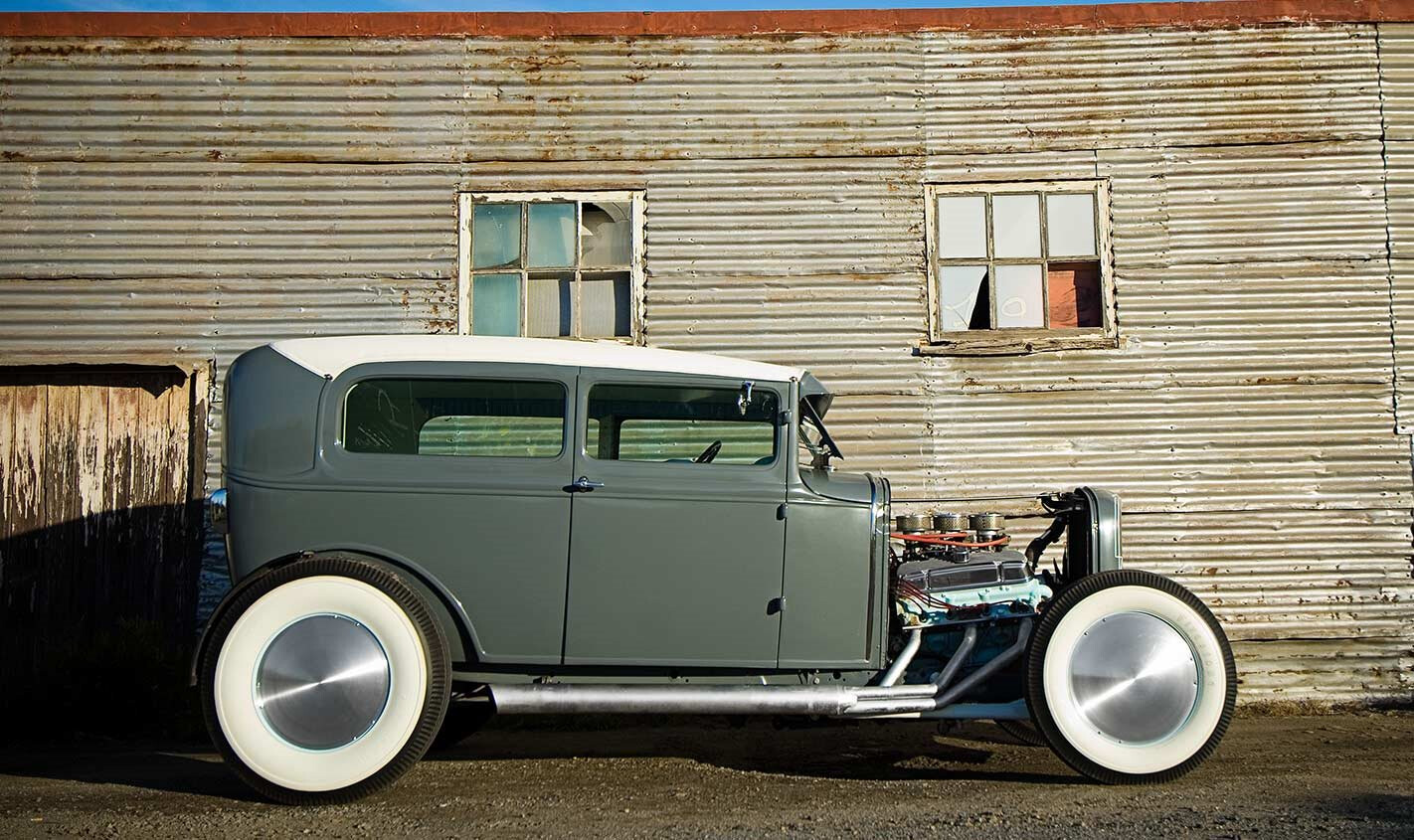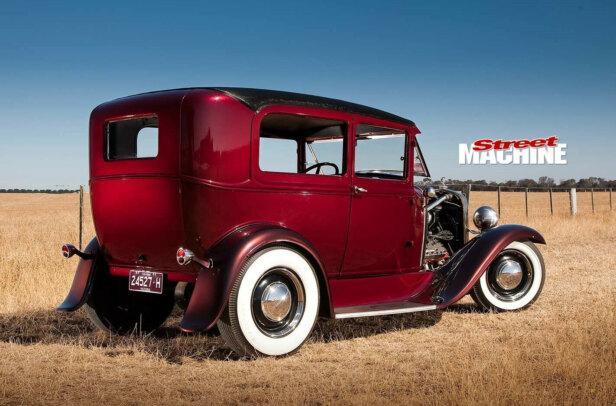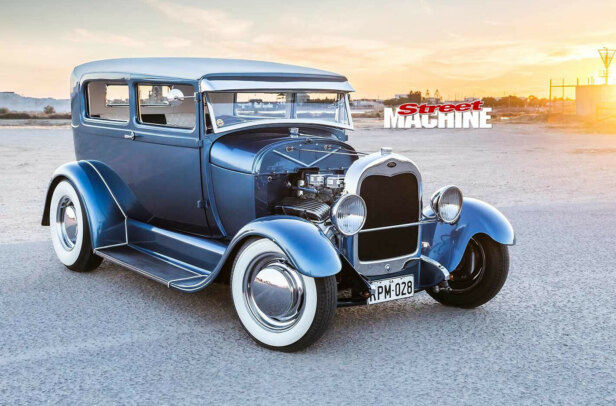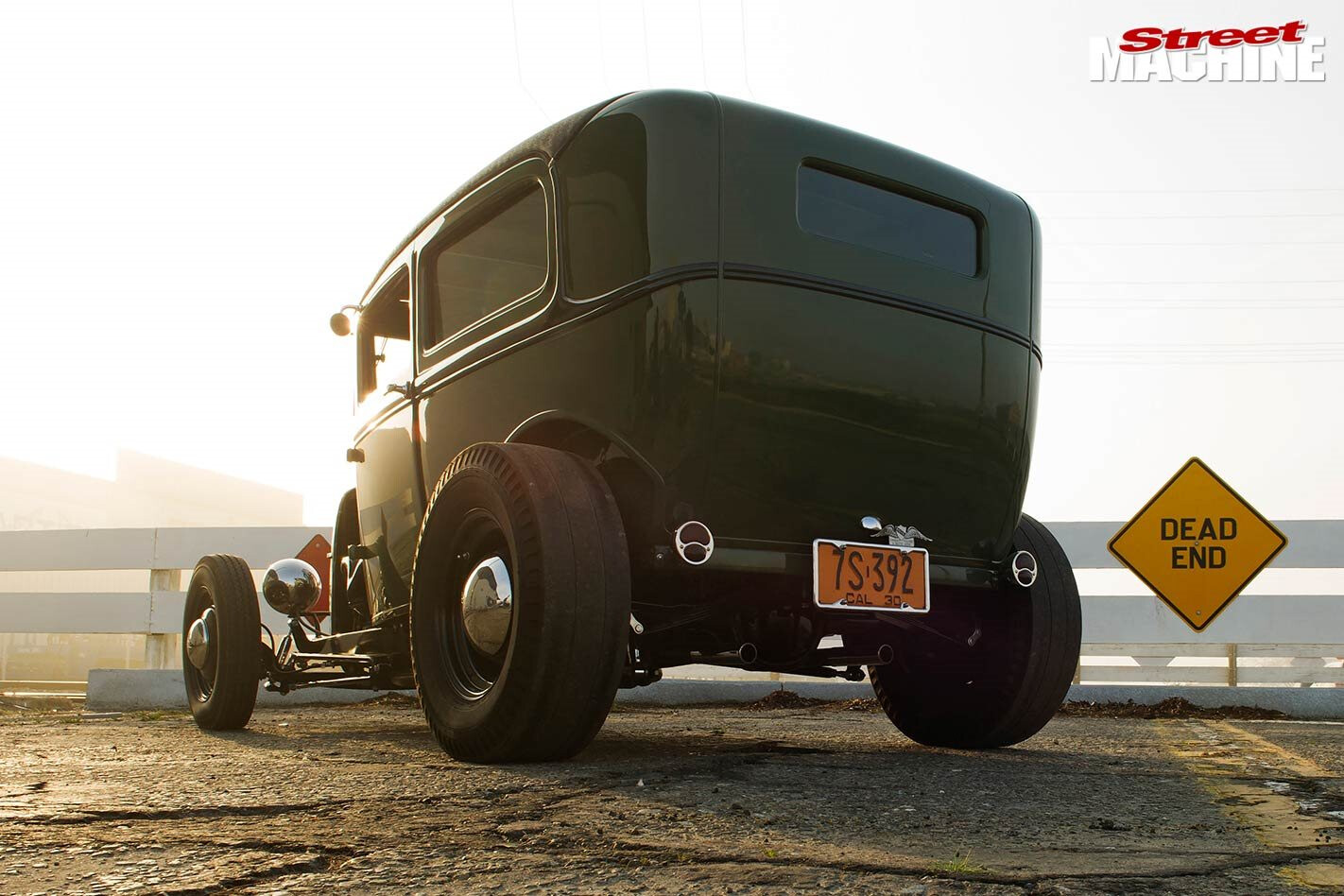This article on Michael Ahren’s Ford Tudor was originally published in Street Machine’s Hot Rod magazine, 2007
WITH nostalgia riding on the crest of a popularity wave at the moment, Michael Ahrens’s 1931 Model A Tudor might look like any other whitewalled, fenderless hot rod. And quite a plain one at that. Some might think it needs a flame job or racing slicks, maybe a crazy shotgun air-cleaner to give it some more attitude.
But that’s missing the point. Michael reckons the outline and stance are the most important factors in building a hot rod; all other elements are secondary. He sees no need to over-decorate and distract from the simplicity of a cut-down Ford rod. The only way-out crazy thing going on here is this bloke’s intent focus on achieving simplicity.
Back in 1992 Michael started work on his first rod and he wanted to build it like the ones he’d admired in Dad’s old Rod and Custom and Car Craft mags of the early 60s.
He says: “I just thought that was how all hot rods should look. But when I started asking around about building , the only advice I got was to build like others were building at the time or my car wouldn’t pass its roadworthy inspection.”
It seems that details like drums brakes, split radius rods and cross-ply tyres on a short wheelbase weren’t too popular with the roads authorities in Adelaide back then.
But Michael simply didn’t accept that he couldn’t build a car like the ones in those crumbling magazines.
“I did more research until I could understand which advice to take and which I should politely ignore,” he says.
Michael seems to have some ‘baggage’ from the early days of his first build: “I bought a lot of mistaken advice when I was starting out and try to do my best to educate people new to hot rods so they don’t get the same ridicule for asking the ‘wrong’ questions,” he says. “Stick to what you want to do and make it work, whatever it takes. The odd fool along the way might give you grief but if you’re dedicated, you’ll outlast these people and their narrow minds.”
This Tudor project has been an off-again on-again undertaking since 1998. Michael began with a battered but mostly rust-free body and a fairly incomplete original chassis.
“The chassis had been stripped of all its brackets,” he says, “but that was fine, because I didn’t need all that junk anyway.
Pinstriping is Michael’s own handiwork. Grille is a ’32
“By chance I bought an old Pontiac Strato- Streak V8 that looked to be a good thing and its sheer physical size — nice and big — meant it was perfect to fit in front of a tiny Model A cowl.”
He took the engine home and set it up on a tube frame to run in the garage, with a gravity-feed fuel tin and an old radiator.
“I wired up the generator and ran it without headers as party entertainment. It had good vaccum signal and oil pressure, so I thought: ‘Shit, I better do something with this.’”
Two trips to the States, collecting a few parts along the way, meant that serious progress began in 2004. Among the goodies he picked up was the Offenhauser triple carb manifold, from Blair’s Speed Shop in Pasedena. “They were using it as a doorstop, but they still charged me $100.”
Behind the Poncho motor and sending the power out back is an XE Falcon BorgWarner three-speed auto.
“They’re a bit of a favourite with me — compact, cheap with the shifter close to the ’box.”
Speco still makes Transit van shifters for them too. They sit upright and are a whole lot nicer than trying to use a worn swap-meet shifter.
With the parts on hand, Michael spent a lot of time laying out the frame, keeping the axles wide and the tyres tall to take bulk and height from the body and highlight the 4.5in taken out of the roof.
“I’ve got a thing about using the widest possible axle to get the wheels away from the grille — I think a lot of cars look crowded at the front. Most people get sold a 46in front axle, but they’re for fendered cars — if you have a hi-boy, you need the 48.”
Stunning blue and white tuck ’n’ roll trim was done by Wayne Norton, over Mini buckets. Instruments and tiller are ’49 Pontiac
Getting those details right is what rod building is all about to Michael.
“Hot rods are what I do. I work a job at a dealership but my nine-to-five doesn’t give me a kick anywhere near that of rodding. Being a mechanic and servicing what already exists doesn’t have the same appeal as creating a car out of bunch of old bits. The more I work on newer cars, the more I want to make my own brackets and linkages rather than adapt some piece off, say, an 80s Toyota.”
Narrowed ’41 Ford dash was filled, sectioned, diced, tacked and smoothed with the finest craftsmanship in a can
Such is the attraction of early Ford mechanisms, linkages, pressings and castings to Michael that there’s almost no substitute. If he can’t find a Ford piece to use, he’ll go off and make something with the primitive effectiveness of those older Ford designs in mind.
PONCHO POWER!
The engine came out of an old speedway car, though little is known of its history. It’s Pontiac’s first modern overhead valve V8 engine, from 1955. They started at 287ci and grew to 389ci by 1959.
The Pontiac Strato-Streak V8 displaces 287ci and runs an with Offy single plane tri-power and Rochester two-barrels. Sweet
Pontiacs were known for their low-down torque and while the company was trying to shake off its staid reputation, the donks were available with many different induction systems, including triple two-barrels and dual quads. The oiling system is comparable to Ford’s Cleveland, with its ‘afterthought’ crankshaft lubrication suffering similar shortcomings and some disastrous big-end failures in early NASCAR racing.
The 287 had other short-lived features including a reverse-flow cooling system with brass tubes that directed cool water to the exhaust valves, and small, drilled vents for the intake valve stems. These revolutionary breakthroughs were all phased out by 1961, either for design improvement or simple cost-cutting
MICHAEL AHRENS
1931 FORD TUDOR
Colour: Protech Dark Admiralty Grey
ENGINE
Brand: Pontiac V8 287ci
Induction: Offy single-plane Tri-Power with Rochester two-barrels
Cooling: Custom-made four-row radiator
Exhaust: Home-made with baffled side-pipes
Internals: Bone stock
TRANSMISSION
Gearbox: Ford XE BorgWarner three-speed manual
Shifter: Speco Transit van
Diff: ’62 Ford Galaxie
SUSPENSION & BRAKES
Front: Rodtech spring on 48in Superbell axle
Rear: ’40 buggy front spring with triangulated ladder bar
Steering: ’45 Ford 1½-ton truck
Brakes: ’53 Ford F100 (f) on ’48 Ford spindles with Chassis Engineering deep-drop steering arms, ’62 Ford drums with 11/16th-in wheel cylinders (r)
INTERIOR
Seats: Early Morris Mini with cut-down bases (f), home-made, foam on ply (r)
Dash: ’41 Ford, narrowed 8in
Instruments: ’49 Pontiac with Voltage drop resistor for electric fuel and temp gauges, HK Holden fuel gauge sender unit mounted in tank behind dashboard
Stereo: Dual exhausts
ROLLING STOCK
Tyres: Firestone Deluxe Champion whitewall 6.00×16 (f) 7.50×16 (r)
Wheels: ’48 Ford 16×4.5 reversed (f), ’51 Ford 16in centres in ’62 International pick-up truck 16×5 rims, reversed (r)




Comments